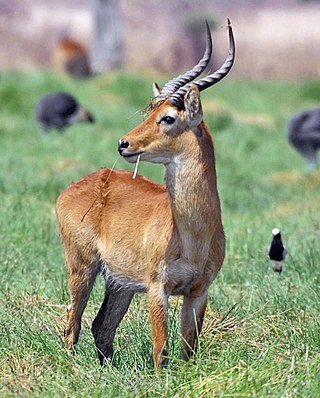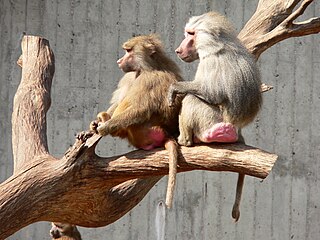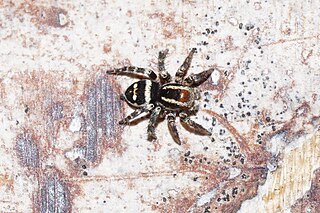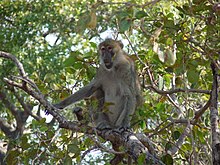
The gelada, sometimes called the bleeding-heart monkey or the gelada baboon, is a species of Old World monkey found only in the Ethiopian Highlands, living at elevations of 1,800–4,400 m (5,900–14,400 ft) above sea level. It is the only living member of the genus Theropithecus, a name derived from the Greek root words for "beast-ape". Like its close relatives in genus Papio, the baboons, it is largely terrestrial, spending much of its time foraging in grasslands, with grasses comprising up to 90% of its diet.

The olive baboon, also called the Anubis baboon, is a member of the family Cercopithecidae Old World monkeys. The species is the most wide-ranging of all baboons, being native to 25 countries throughout Africa, extending from Mali eastward to Ethiopia and Tanzania. Isolated populations are also present in some mountainous regions of the Sahara. It inhabits savannahs, steppes, and forests. The common name is derived from its coat colour, which is a shade of green-grey at a distance. A variety of communications, vocal and non-vocal, facilitate a complex social structure.

The puku is a medium-sized antelope found in wet grasslands in southern Democratic Republic of Congo, Namibia, Tanzania, Zambia and more concentrated in the Okavango Delta in Botswana. Nearly one-third of all puku are found in protected areas, zoos, and national parks due to their diminishing habitat.

The yellow baboon is a baboon in the family of Old World monkeys. The species epithet means "dog-head" in Greek, due to the dog-like shape of the muzzle and head. Yellow baboons have slim bodies with long arms and legs along with yellowish-brown hair. They resemble the Chacma baboon, but are somewhat smaller and with a less elongated muzzle. Their hairless faces are black, framed with white sideburns. Males can grow to about 84 cm, females to about 60 cm. They have long tails which grow to be nearly as long as their bodies. The average life span of the yellow baboon in the wild is roughly 15–20 years; some may live up to 30 years.

The hamadryas baboon is a species of baboon within the Old World monkey family. It is the northernmost of all the baboons, being native to the Horn of Africa and the southwestern region of the Arabian Peninsula. These regions provide habitats with the advantage for this species of fewer natural predators than central or southern Africa where other baboons reside. The hamadryas baboon was a sacred animal to the ancient Egyptians and appears in various roles in ancient Egyptian religion, hence its alternative name of 'sacred baboon'.

The Guinea baboon is a baboon from the Old World monkey family. Some (older) classifications list only two species in the genus Papio, this one and the hamadryas baboon. In those classifications, all other Papio species are considered subspecies of P. papio and the species is called the savanna baboon.

The chacma baboon, also known as the Cape baboon, is, like all other baboons, from the Old World monkey family. It is one of the largest of all monkeys. Located primarily in southern Africa, the chacma baboon has a wide variety of social behaviours, including a dominance hierarchy, collective foraging, adoption of young by females, and friendship pairings. These behaviors form parts of a complex evolutionary ecology. In general, the species is not threatened, but human population pressure has increased contact between humans and baboons. Hunting, trapping, and accidents kill or remove many baboons from the wild, thereby reducing baboon numbers and disrupting their social structure.

Cathemerality, sometimes called "metaturnality", is an organismal activity pattern of irregular intervals during the day or night in which food is acquired, socializing with other organisms occurs, and any other activities necessary for livelihood are undertaken. This activity differs from the generally monophasic pattern of nocturnal and diurnal species as it is polyphasic and is approximately evenly distributed throughout the 24-hour cycle.

The Lochinvar National Park lies south west of Lusaka in Zambia, on the south side of the Kafue River.

Berenty Reserve is a small private reserve, near Amboasary Sud, Anosy. It is situated along the Mandrare River, set in the semi-arid spiny forest ecoregion of the far south of Madagascar. For more than three decades the late primatologist Alison Jolly, other researchers and students have visited Berenty to conduct fieldwork on lemurs. The reserve is also a favourite for visitors who want to see some of Madagascar's endemic bird species, which include owls and couas.

The wildlife of Zambia refers to the natural flora and fauna of Zambia. This article provides an overview, and outline of the main wildlife areas or regions, and compact lists of animals focusing on prevalence and distribution in the country rather than on taxonomy. More specialized articles on particular groups are linked from here.
The Amboseli Baboon Project is a long-term, individual-based research project on yellow baboons in the Amboseli basin of southern Kenya. Founded in 1971, it is one of the longest-running studies of a wild primate in the world. Research at the Amboseli Baboon Project centers on processes at the individual, group, and population levels, and in recent years has also included other aspects of baboon biology, such as genetics, hormones, nutrition, hybridization, parasitology, and relations with other species. The project is affiliated with the Department of Ecology and Evolutionary Biology at Princeton University, the Department of Biology and the Evolutionary Anthropology Department at Duke University, and the Department of Biological Sciences at the University of Notre Dame.

Baboons are primates comprising the genus Papio, one of the 23 genera of Old World monkeys, in the family Cercopithecidae. There are six species of baboon: the hamadryas baboon, the Guinea baboon, the olive baboon, the yellow baboon, the Kinda baboon and the chacma baboon. Each species is native to one of six areas of Africa and the hamadryas baboon is also native to part of the Arabian Peninsula. Baboons are among the largest non-hominoid primates and have existed for at least two million years.

Dinopithecus is an extinct genus of very large primate closely related to the baboon that lived during the Pliocene to the Pleistocene epoch of South Africa and Ethiopia. It was named by British paleontologist Robert Broom in 1937. The only species currently recognized is Dinopithecus ingens, as D. quadratirostris has been reassigned to the genus Soromandrillus. It is known from several infilled cave sites in South Africa, all of early Pleistocene age, including Skurweberg, Swartkrans, and Sterkfontein.
Contact calls are seemingly haphazard sounds made by many social animals. Contact calls are unlike other calls in that they are not usually widely used, conspicuous calls, but rather short exclamations that differ between individuals. Often, the message that the call is meant to convey is specific to the individual or group's activity, such as informing other members of the group about one's location while foraging for food. Some social animal species communicate the signal of potential danger by stopping contact calls, without the use of alarm calls. Charles Darwin wrote about this in relation to wild horse and cattle.
Hepatocystis is a genus of parasites transmitted by midges of the genus Culicoides. Hosts include Old World primates, bats, hippopotamus and squirrels. This genus is not found in the New World. The genus was erected by Levaditi and Schoen, 1932, as Hepatocystes.
In biology, paternal care is parental investment provided by a male to his own offspring. It is a complex social behaviour in vertebrates associated with animal mating systems, life history traits, and ecology. Paternal care may be provided in concert with the mother or, more rarely, by the male alone.
Susan C. Alberts is an American primatologist, anthropologist, and biologist who is the current Chair of the Department of Evolutionary Anthropology at Duke University; previously, she served as a Bass fellow and the Robert F. Durden Professor of Biology at Duke. She currently co-directs the Amboseli Baboon Research Project with Jeanne Altmann of Princeton University. Her research broadly studies how animal behavior evolved in mammals, with a specific focus on the social behavior, demography, and genetics of the yellow baboon, although some of her work has included the African elephant. She was elected a fellow of the American Academy of Arts and Sciences in 2014, won the Cozzarelli Prize of the National Academy of Sciences in 2016, and was elected a fellow of the National Academy of Sciences in 2019.

Stenaelurillus zambiensis is a species of jumping spider in the genus Stenaelurillus that lives in Malawi, Zambia and Zimbabwe. It was first described in 2014 by Wanda Wesołowska. The spider is small, the male being smaller than the female, with a brown carapace between 2.6 and 3.2 mm in length and black-brown abdomen between 2.6 and 3.0 mm in length. The male has a distinctive metallic sheen on its abdomen and eye field. The male carapace is marked with two white streaks while the female has white stripes. It is distinguished from other members of the genus by the male's hook-shaped end to the embolus and the two depressions in the female epigyne.
The Njesi Highlands are a range of mountains in northern Mozambique.
















